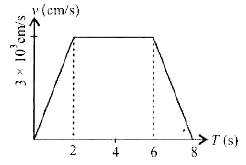If the velocity of a car is given by V=(150−10x)1/2 m/s . If car retards their motion by applying brakes then what will be the acceleration ?
1m/s2
2m/s2
5m/s2
−5m/s2
The correct Answer is:D
To find the acceleration of the car when it is retarding its motion, we start with the given velocity function:
V=(150−10x)1/2m/s
Step 1: Differentiate the velocity with respect to time
Acceleration a is defined as the rate of change of velocity with respect to time, which can be expressed as:
a=dVdt
Using the chain rule, we can express this as:
a=dVdx⋅dxdt
Where dxdt is the velocity V.
Step 2: Differentiate V with respect to x
To find dVdx, we differentiate the velocity function:
V=(150−10x)1/2
Using the power rule and chain rule, we get:
dVdx=12(150−10x)−1/2⋅(−10)
This simplifies to:
dVdx=−5(150−10x)1/2
Step 3: Substitute dxdt with V
Now, substituting dxdt=V into the expression for acceleration:
a=dVdx⋅V
Substituting dVdx:
a=−5(150−10x)1/2⋅V
Step 4: Substitute V back into the equation
Since V=(150−10x)1/2, we can substitute this back into the equation for acceleration:
a=−5(150−10x)1/2⋅(150−10x)1/2
This simplifies to:
a=−5m/s2
Conclusion
Thus, the acceleration of the car when it applies brakes is:
a=−5m/s2
Acceleration a is defined as the rate of change of velocity with respect to time, which can be expressed as:
To find dVdx, we differentiate the velocity function:
Now, substituting dxdt=V into the expression for acceleration:
Since V=(150−10x)1/2, we can substitute this back into the equation for acceleration:
Thus, the acceleration of the car when it applies brakes is:
Topper's Solved these Questions
- MOTION IN A STRAIGHT LINEBook:PHYSICS WALLAHChapter:MOTION IN A STRAIGHT LINEExercise:Level-2
Explore 27 Videos
- MOTION IN A STRAIGHT LINEBook:PHYSICS WALLAHChapter:MOTION IN A STRAIGHT LINEExercise:NEET Past 5 Years Questions
Explore 5 Videos
- MOTION IN A PLANE Book:PHYSICS WALLAHChapter:MOTION IN A PLANE Exercise:NEET Past 5 years Questions
Explore 10 Videos
- MOVING CHARGES AND MAGNETISM Book:PHYSICS WALLAHChapter:MOVING CHARGES AND MAGNETISM Exercise:NEET PAST 5 YEARS QUESTIONS
Explore 12 Videos
Similar Questions
The speed of a moving car is 60kmh−1. The wheels having diameter of 0.60 m are stopped in 10 rotations by applying brakes. What will be the angular retardation produced by brakes?
View SolutionA car is moving at a speed of 72km/h. The diamter of its whells is 0.5m. If the wheels are stopped in 20 rotations by applying brakes, calcualte the angular retardation produced by the brakes.
View Solution
Knowledge Check
The engine of a car produces acceleration 4m/s2 in the car. If this acr pulls another car of same mass, what will be the acceleration produced
A8m/s2B2m/s2C4m/s2D12m/s2A car of mass M accelerates starting from rest. Velocity of the car is given by v=(2PtM)12 where P is the constant power supplied by the engine. The position of car as a function of time is given as
A(8P9M)12t32B(9P8M)12t32C(8P9M)12t23D(9P8M)t3The velocity time graph of the motion of a car is given here.
 AThe distance travelled by the car in the first six seconds is 150 m.BThe deceleration of the car during the last two seconds are −15ms2.CThe distance travelled by the car in the first six second is 220 m.DThe deceleration of the car during the last two second is −20ms2
AThe distance travelled by the car in the first six seconds is 150 m.BThe deceleration of the car during the last two seconds are −15ms2.CThe distance travelled by the car in the first six second is 220 m.DThe deceleration of the car during the last two second is −20ms2
A car is moving at a speed of 72kmh−1. The diameter of its wheel is 0.50m. If the wheels are stopped in 20 rotations by applying brakes, calculate the angular retardation produced by the brakes.
View SolutionFind the initial velocity of a car which is stopped in 10 seconds by applying brakes. The retardation due to brakes is 2.5 m/s2.
View SolutionThe velocity of a car changes from −5ms−1 to−7ms−1 in 2 s. What is the acceleration of the car? What does the negative sign suggest?
View SolutionA car start moving with uniform acceleration from its position of rest and it moves 100 m is 10 s. On applying brakes, it stops after covering 50 m. Then the magnitude of acceleration in the second part of its motion is ______ m s−2.
View SolutionA motor car, starting from rest, moves with uniform acceleration and attains a velocity of 8ms−1 in 8 s. It then moves with uniform velocity and finally brought to rest in 32 m under unifrom retardation. The total distance covered by the car is 464 m. Find the acceleration.
View Solution